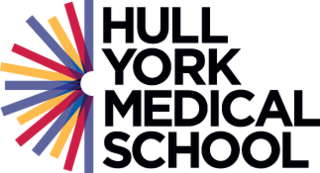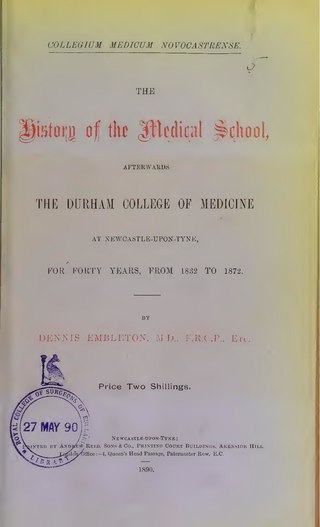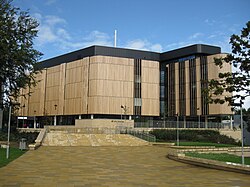Doctor of Medicine is a medical degree, the meaning of which varies between different jurisdictions. In the United States, and some other countries, the M.D. denotes a professional degree. This generally arose because many in 18th-century medical professions trained in Scotland, which used the M.D. degree nomenclature. In England, however, Bachelor of Medicine, Bachelor of Surgery was used and eventually in the 19th century became the standard in Scotland too. Thus, in the United Kingdom, Ireland and other countries, the M.D. is a research doctorate, honorary doctorate or applied clinical degree restricted to those who already hold a professional degree (Bachelor's/Master's/Doctoral) in medicine. In those countries, the equivalent professional degree to the North American, and some others' usage of M.D. is still typically titled Bachelor of Medicine, Bachelor of Surgery (M.B.B.S.).
A medical school is a tertiary educational institution, professional school, or forms a part of such an institution, that teaches medicine, and awards a professional degree for physicians. Such medical degrees include the Bachelor of Medicine, Bachelor of Surgery, Master of Medicine, Doctor of Medicine (MD), or Doctor of Osteopathic Medicine (DO). Many medical schools offer additional degrees, such as a Doctor of Philosophy (PhD), master's degree (MSc) or other post-secondary education.
A Bachelor of Medicine, Bachelor of Surgery is an undergraduate medical degree awarded by medical schools in countries that follow the tradition of the United Kingdom. The historical degree nomenclature states that they are two separate undergraduate degrees. In practice, however, they are usually combined as one and conferred together, and may also be awarded at graduate-level medical schools. It usually takes five to six years to complete this degree.

In the United Kingdom, medical school generally refers to a department within a university which is involved in the education of future medical practitioners. All leading British medical schools are state-funded and their core purpose is to train doctors on behalf of the National Health Service. Courses generally last four to six years: two years of pre-clinical training in an academic environment and two to three years clinical training at a teaching hospital and in community settings. Medical schools and teaching hospitals are closely integrated. The course of study is extended to six years if an intercalated degree is taken in a related subject.

Hull York Medical School (HYMS) is a medical school in England which took its first intake of students in 2003. It was opened as a part of the British Government's attempts to train more doctors, along with Brighton and Sussex Medical School, Peninsula Medical School and University of East Anglia Medical School.

The University of Birmingham Medical School is one of Britain's largest and oldest medical schools with over 400 medical, 70 pharmacy, 140 biomedical science and 130 nursing students graduating each year. It is based at the University of Birmingham in Edgbaston, Birmingham, United Kingdom. Since 2008, the medical school is a constituent of The College of Medical and Dental Sciences.

Brighton and Sussex Medical School (BSMS) is a medical school formed as a partnership of the University of Brighton and the University of Sussex. Like other UK medical schools it is based on the principles and standards of 'Tomorrow's Doctors', an initiative by the General Medical Council outlining the role of British practitioners. Since opening in 2003, BSMS has produced more than 1,500 new doctors who now work across the UK.

Newcastle University School of Medicine is the medical school at Newcastle University in England. It was established in 1834 in the city of Newcastle upon Tyne and served as the College of Medicine in connection with Durham University from 1851 to 1870 and then, as a full college of the university, Durham University College of Medicine from 1870 to 1937 when it joined Armstrong College, to form King's College, Durham. In 1963 King's College became the University of Newcastle upon Tyne. The university now uses the name "Newcastle University".

The School of Medicine is the medical school of the University of Leeds, in the city of Leeds, West Yorkshire, England. The School of Medicine was founded in 1831.

Leicester Medical School is a medical school, which is part of the University of Leicester. The school was founded in 1975, although between 2000 and 2007 it was part of the joint Leicester-Warwick Medical School. As of 2021, the medical school admits 290 students per year including 18 students from overseas. Leicester was ranked 5th in the UK, among 33 medical schools in the 2020 Shanghai Ranking of World Universities. In the same rankings, Leicester was ranked 20th globally. Leicester Medical School is the first UK medical school to adopt a one-iPad-per-student programme at the undergraduate level, commencing in 2013. Leicester Medical School is one of the few UK medical schools offering full-body cadaveric dissection as part of their clinical teaching.
Durham University School of Medicine, Pharmacy and Health was founded on Teesside in 2001 as a partner with the Newcastle University Medical School to educate medical students in the first phase of their medical education. On 1 August 2017 it was transferred to Newcastle University, becoming part of Newcastle's Faculty of Medical Sciences and relocating to Newcastle.

The University of Nottingham Medical School is the medical school of the University of Nottingham, Nottingham, UK. Its first intake of 48 students graduated in 1975. Student intake has steadily increased to a current level of 330 students per year, including 90 from the satellite graduate-entry school at Derby, which opened in 2003.
The University of Edinburgh Medical School is the medical school of the University of Edinburgh in Scotland and the United Kingdom and part of the College of Medicine and Veterinary Medicine. It was established in 1726, during the Scottish Enlightenment, making it the oldest medical school in the United Kingdom and the oldest medical school in the English-speaking world.

Swansea University Medical School is a medical school on Swansea University's Singleton campus. It is linked to additional teaching centres located throughout South and West Wales, including Cefn Coed Hospital, Singleton Hospital and Morriston Hospital in Swansea, Prince Philip Hospital in Llanelli, Withybush General Hospital in Haverfordwest and Bronglais Hospital in Aberystwyth. The Medical School also has a network of primary care teaching centers.

A Bachelor of Medical Sciences (BMedSci, BMedSc, BSc(Med), BMSc) is an undergraduate academic degree involving study of a variety of disciplines related to human health leading to an in depth understanding of human biology and associated research skills such as study design, statistics and laboratory techniques. Such disciplines include biochemistry, cell biology, physiology, pharmacology or psychosocial aspects of health. It is an equivalent level qualification to the more commonly awarded Bachelor of Science (BSc). Graduates may enter a diverse range of roles including post-graduate study, higher education, the biotechnology industry, the pharmaceutical industry, consultancy roles, scientific communication, education or unrelated disciplines which make use of the broad range of transferable skills gained through this degree.
Lancaster Medical School (LMS) is located in Lancaster, Lancashire in North West England and is part of the Faculty of Health and Medicine at Lancaster University. It is currently the UK's newest public medical school, with its first graduates, a cohort of 31, graduating in 2011. The current head of the medical school is Professor Marina Anderson.
Norwich Medical School is a medical school based at the University of East Anglia, in Norwich, England. It is part of the Faculty of Medicine and Health sciences at the university. The first intake of students was in 2002. The school has a 5-year MBBS course, with the possibility of intercalation after year 3 or 4.
Oxford University Medical School is the medical school of the University of Oxford in the city of Oxford, England. It is a component of the Medical Sciences Division, and teaching is carried out in its various constituent departments.










